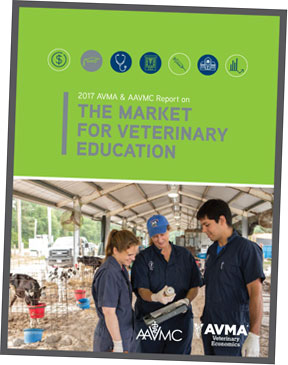Salaries, debt increase slightly for new graduates

Starting salaries for new veterinary college graduates continue to increase overall, but so does educational debt. In fact, for every sector of the profession, the growth rate for educational debt has continued to outpace the growth rate for starting salaries, according to the 2017 AVMA & Association of American Veterinary Medical Colleges Report on the Market for Veterinary Education. Still, for 2016, the debt-to-income ratio was 2:1, which was essentially unchanged from the 2015 ratio of 1.99:1.
At last year's Fix the Debt summit, which brought together 180 attendees representing various facets of the profession, the goal was to agree on strategies to lower the DIR to 1.41:1 by 2025 (see JAVMA, June 15, 2016).
"This ratio helps establish a picture of the connection between the demand and supply of new veterinarians through understanding the cost to obtain a DVM degree, and the subsequent income that is the payback to the veterinarian for acquiring it," according to the report.
The report, released in mid-June, derives much of its information from the AVMA Senior Survey conducted each spring among the graduating students of U.S. veterinary colleges accredited by the AVMA Council on Education. The document takes an in-depth look at new-veterinarian incomes, educational debt load, the veterinary student applicant pool, and veterinary colleges' supply of seats as well as the debt-to-income ratio and strategies to improve the ratio.
Some key findings in the report are as follows:
- About 93 percent of last year's graduating veterinary students had found full-time employment or received offers to pursue postgraduate education at the time of the survey. The percentage who found full-time employment was 54.9 percent, an increase from 48.9 percent in 2015. Meanwhile, internship participation has decreased from 35.6 percent in 2015 to 31.6 percent in 2016.
- From 2001-2016, the mean starting salary for new graduates increased from just under $40,000 to more than $58,000—a mean increase of $1,220 per year. These numbers are inclusive of those finding full-time employment along with those pursuing internships, residencies, and advanced education.
- The weighted, mean starting salary for 2016 graduates finding full-time employment prior to graduation was $73,380, up from $70,117 in 2015. Those pursuing internships had mean annual earnings of $30,829.
- The real weighted mean debt of all U.S. respondents reporting debt for the 2016 graduating class was $143,758, an increase from $141,354 in 2015.
- The majority (68.2 percent) of 2016 graduates had debt-to-income ratios that exceeded the 1.4:1 DIR considered to be an upper boundary for an acceptable level of financial stress.
- About 14 percent of those surveyed reported no debt, up from approximately 11 percent the previous year.
The 2017 AVMA & AAVMC Report on Veterinary Markets is available for free download by AVMA members at jav.ma/2017markets, and the report series is available for purchase by others.
Two upcoming economic reports will cover the market for veterinarians and the market for veterinary services.
Related JAVMA content:
Pulling together to lower the debt-to-income ratio (June 15, 2016)